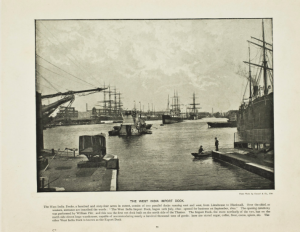In the metropolitan work district of Poplar, at the start of the 19th century, there were no institutions. The long, narrow district on London’s east side appears to have been lightly populated between the years of 1801 and 1810, with only 8,278 persons, and thus might not have placed great demand upon the city for infrastructure and institutions. Over the course of the 19th century, however, Poplar’s population seems to have grown and evolved, and the institutions grew with it.

What might be most interesting about the majority of Poplar’s institutions is their focus. While the district saw an increase in workhouses and hospitals and the addition of a lunatic asylum between the years of 1801 and 1890, the most pressing issue for the area was the increase in dockworkers and sailors. The Thames marks Poplar’s southern border, and within that particular stretch of the river sits the Isle of the Dogs, now known as “the Island.” This peninsula was significant because it housed both the East India and West India docks, the sites at which imports from the West Indies and the British East Indian Company entered the city for trade.
The institutions added to the area of Poplar reflect the growth of this trade and of the population of dockworkers. Between 1851 and 1860, the Poplar Hospital For Accidents appeared on Lodore Street. The hospital was founded originally to serve only the East and West India dockworkers, suggesting that there were large numbers of dockworkers, and large enough numbers of them receiving injuries, that the city had to build a hospital to serve them exclusively. Other institutions that arose as a result of the docks were the two Missions to Seamen founded in 1881; one was in St Luke’s Church on Stratford Street, and the other was in Poplar Church on the corner of East India Dock Road and Chrisp Street.
The two workhouses added to Poplar—the first, the Bow Road Workhouse on the border of Poplar and Mile End Town Vestry, and the second, the St Leonards Street Workhouse—suggest an influx of working class and poor migrants entering the district starting in the middle of the century, likely corresponding with the rise in activity at the docks.
